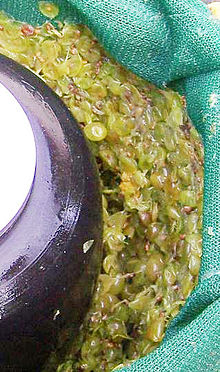Pomace

Pomace (ultimately from Latin pomum 'apple') is the solid remains of olives, grapes, or other fruit after pressing for juice or oil. It is essentially the pulp, peel, seeds and stalks of the fruit after the oil, water, or other liquid has been pressed out. Grape pomace has traditionally been used to produce grape seed oil, a practice that continues to this day in small amounts, and Pommace brandy, such as grappa. Today, pomace is most commonly used as fodder or fertilizer. Another pomace by-product is the natural red dye and food coloring agent oenocyanin. However, some companies are also recovering tartrates (cream of tartar) as well as grape polyphenols.[1]
History
The English were the first to widely use the term "pomace" to refer to the by product from cider production.[1] In the Middle Ages, pomace wines with a low alcohol content of three to four percent were widely available. These faux-wines were made by rehydrating and refermenting the pomace after pressing. Generally, medieval wines were not fermented to dryness so the pomace contained a small amount of fermentable sugars.
Piquette
The Ancient Greeks and Romans would use pomace to create a wine known as piquette. This was a low-end wine that was normally given to slaves and common workers. After the wine grapes were pressed twice, the pomace was soaked in water for a day and pressed for a third time. The resulting liquid was mixed with more water to produce a thin, tepid wine that was not very appealing.[2]
Wines & brandies
Apple pomace is often used to produce pectin, or can be used to make Ciderkin, a weak cider. While grape pomace is used to produce pomace wine and pomace brandy, such as grappa (in Italy), marc (in France), zivania (in Cyprus), lozovača or komovica (in Croatia), Raki (in Turkey and Albania), Orujo (in Spain), Tsikoudia (in Crete), Tsipouro in northern Greece or bagaço (in Portugal). There are many other local names and variants such as the English "press cake".[1] Essentially all wine producing cultures started making some form of pomace brandy once the principles of distillation were understood.
In winemaking
The components of pomace in winemaking differs on whether white or red wine is being produced. In red wine production, pomace is produced after the free run juice (the juice created before pressing by the weight of gravity) is poured off, leaving behind dark blackish-red debris consisting of grape skins, stems, as well as dead yeast cells. The color of red wine is derived from skin contact during the maceration period which can sometime include partial fermentation. The resulting pomace is more alcoholic and tannic than pomace produced from white wine production. In white wine production, the grapes are quickly pressed after crushing in order to avoid skin contact with pomace being a by product of the pressing. The resulting debris is a pale, greenish-brow color and contains more residual sugars than tannins & alcohol. This is the pomace normally used in brandy production.[1]
Other uses
Pomace is produced in large qualities in wine production with the issue of disposal being an important environmental consideration. Some wineries will reuse the material as fertilizer while others are exploring options of selling the used pomace to biogas companies to be used in the creation of renewable energy. This alternative form of energy is produced when decomposing pomace is introduced to added microorganism that add in the decomposition process to produce methane gas that can be used for power.[3]
Studies have also shown that specific polyphenols in red wine pomace, may contain properties beneficial for dental hygiene. The study conducted at the Eastman Dental Center found that these polyphenols interferes with Streptococcus mutans, the bacteria in the mouth which causes tooth decay. Professor Hyun Koo, the lead researcher of the study, hopes to isolate these polyphenols to produce new mouthwashes that will help protect against cavities.[4]
A 2004 Turkish study conducted by Erciyes University found that pomace can also act as a natural food preservative that could interfere with Escherichia coli, Salmonella and Staphylococcus bacterias. Scientist used the dried pomace from the white Turkish wine grape Emir Karasi and red Kalecik Karasi to produce a powder that was mixed ethyl acetate, methanol or water and exposed to 14 different types of food bacteria. The results showed that all 14 bacterias were inhibited to some degree by the pomace-depending on the grape variety and the concentration of the extract. The red wine grape Kalecik Karasi was shown to be the most effective due to what the study researchers believe is the higher concentration of polyphenols in red wine grape skins.[5]
See also
References
- ^ a b c d J. Robinson (ed) "The Oxford Companion to Wine" Third Edition pg 534-535 Oxford University Press 2006 ISBN 0198609906
- ^ J. Robinson (ed) "The Oxford Companion to Wine" Third Edition pg 532 Oxford University Press 2006 ISBN 0198609906
- ^ Wine Spectator "Grapevine" Wine Spectator Magazine pg 16, Jan 31st-Feb 29th, 2008
- ^ "Red-wine waste can check cavities" The Times of India, Jan 3rd, 2008
- ^ J. Gaffney "What a Waste! Grape Pomace Kills Food-Spoiling Bacteria" The Wine Spectator, September 23, 2004
External links
- Alison Crowe "The Pomace Predicament" WineMaker Magazine, August 2005
- Y. D. Hang and E. E. Woodams "Grape pomace: A novel substrate for microbial production of citric acid" Biotechnology Letters, Volume 7, Number 4 / April, 1985
